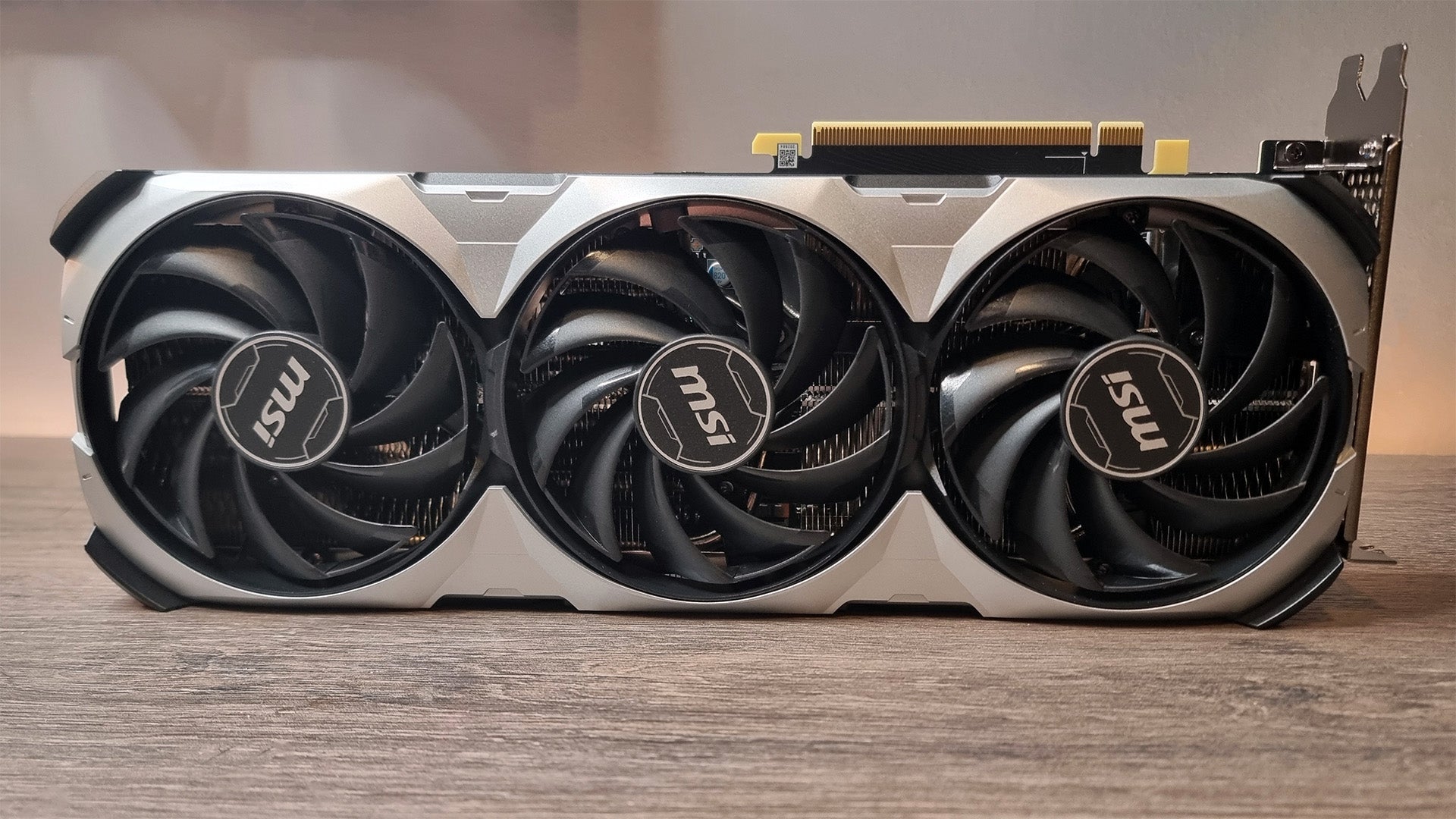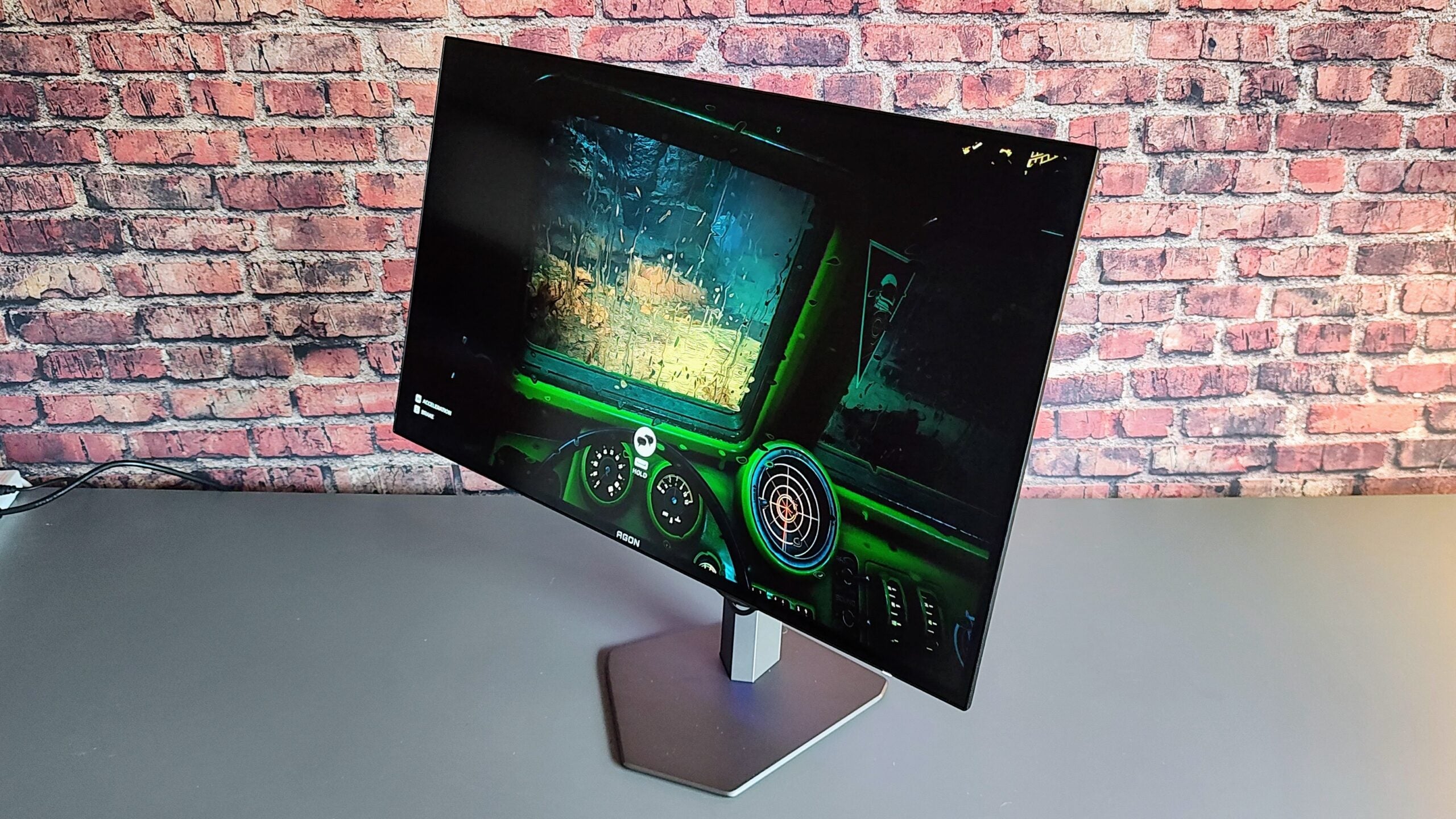Asus ROG Swift OLED PG49WCD Review
A bright and colourful 5K 49-inch ultrawide OLED gaming monitor

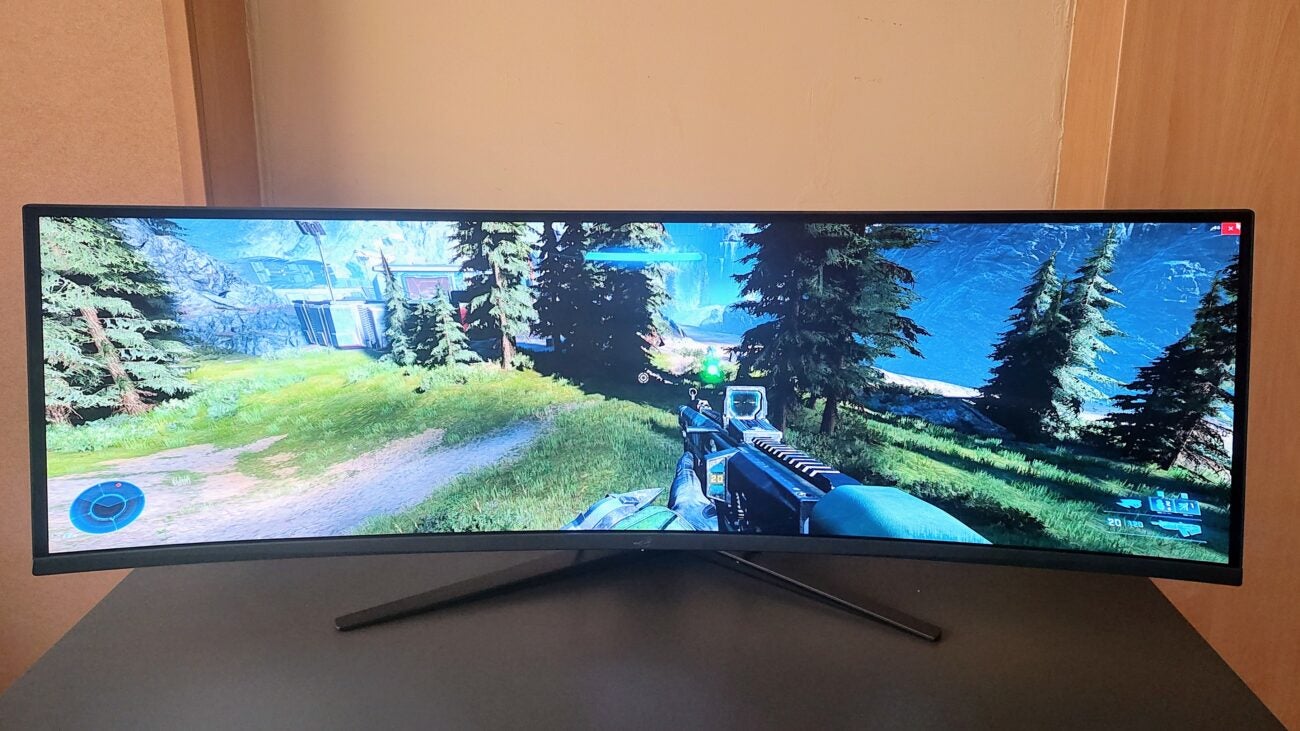
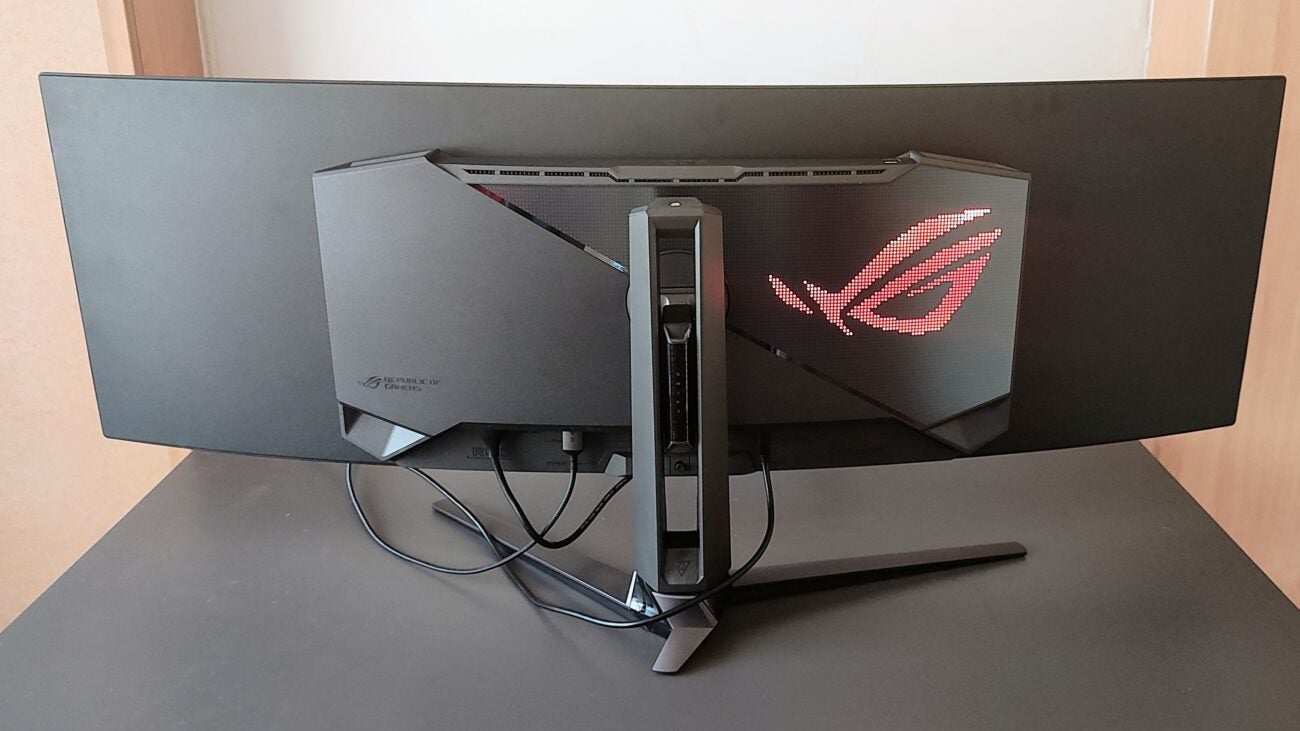


Verdict
The refresh rate could be higher, but for colour, brightness, uniformity and HDR performance, the super-ultrawide Asus ROG Swift OLED PG49WCD gaming monitor is very hard to beat.
Pros
- Bright in SDR and HDR modes
- Full KVM support
- Excellent panel uniformity
- Top-notch motion fidelity
Cons
- Refresh rate on the low side at 144Hz
- No speakers
Key Features
- 49-inch, 5,120 x 1,440 1800R curved OLED displayA 5K OLED display with a refresh rate of 144Hz, an 1800R curve and a G2G response time of 0.03ms guarantees a superbly smooth and immersive Triple-A gaming experience
- Full KVM supportWith USB-B and Type-C DP Alt Mode inputs and a Smart KVM feature you can flip between two sources while using the same monitor, keyboard and mouse.
- No loudspeakersWith no built-in speakers, you will need to budget for something to connect to the SPDIF or 3.5mm audio outputs.
Introduction
The Asus ROG Swift OLED PG49WCD is a new, super-ultrawide 49-inch curved monitor featuring a second-generation Samsung QD-OLED panel.
This new panel boasts a resolution of 5120×1440 and, in this Asus ROG Swift PG49WCD iteration, a maximum refresh rate of 144Hz. It also supports adaptive sync technology in AMD and Nvidia flavours, boasts a very low 0.03ms response time, and has a DisplayHDR True Black 400 certification to guarantee a strong HDR experience.
The Asus ROG Swift OLED PG49WCD isn’t all gaming flash, though. With an effective sRGB clamp and full KVM support, it is equally at home at work as it is at play. It lacks a set of built-in speakers, so you will need to budget for a sound system unless you want to rely on headphones, but other than that, it’s the complete package.
Design and Features
- 49-inch 1800R makes for a very immersive experience
- Good selection of well-positioned I/O ports
- Lacks built-in speakers.
The first thing to note here is the size. With a 32:9 aspect ratio and a 49-inch diagonal, the Asus ROG Swift OLED PG49WCD is the equivalent to having two 27-inch 16:9 monitors side-by-side, making it just shy of 1.2m wide. You must ensure you can sit something this wide on your desk before you get it home and unbox it.
The panel has an 1800R curve, meaning it forms a section of a circle with a radius of 1.8 meters. That makes it ideal for immersive gaming, assuming the games in question support 32:9 ultra-wide; far fewer do than support 21:9. I was recently disappointed to discover that the new adventure game based on Stanisław Lem’s novel Invincible doesn’t. It’s also a format very suitable for work because you can run two 2560 x 720 desktops side-by-side and not have to swivel your head too far left or right to take it all in.
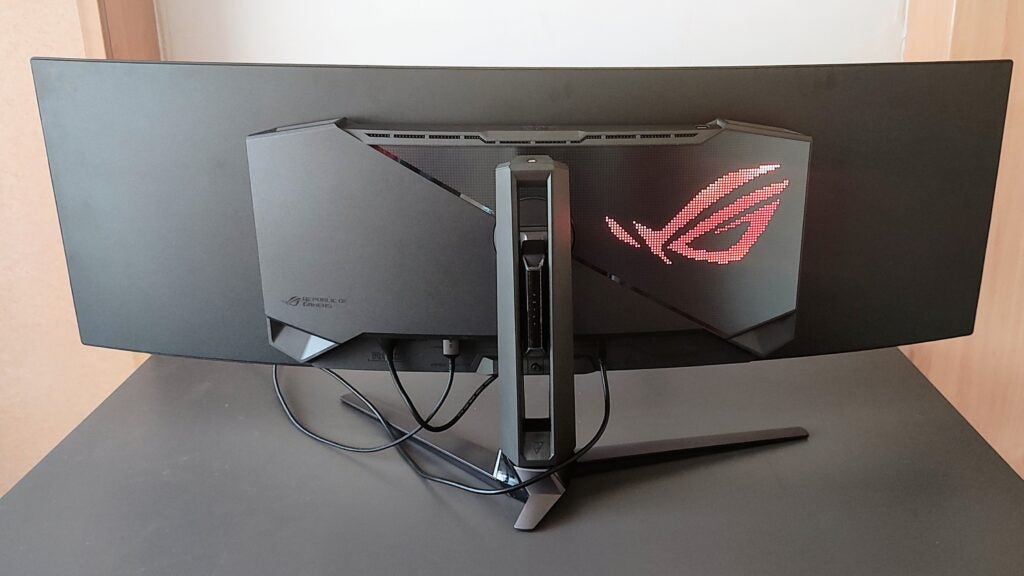
The basic design is similar to other ROG monitors, such as the PG48UQ, which means that the panel section is thin thanks to a central box on the rear housing all the components.
Most of the external surfaces are a matte grey plastic, but the build quality is still good. The rear of the cabinet features a large ROG logo with RGB LED lighting and works with Asus’ Aura Sync cross-device lighting system. The whole unit, including the stand, weighs 11.7Kg which isn’t too bad for such a large assembly.
The stand isn’t as big as you might expect for such a large monitor, with the span between the tips of the feet only 65cm wide. Despite that, stability is good. The central pillar supports height (100mm), swivel (15° L/R) and tilt adjustment (+20°/-5°), which is a good range for such a wide monitor.
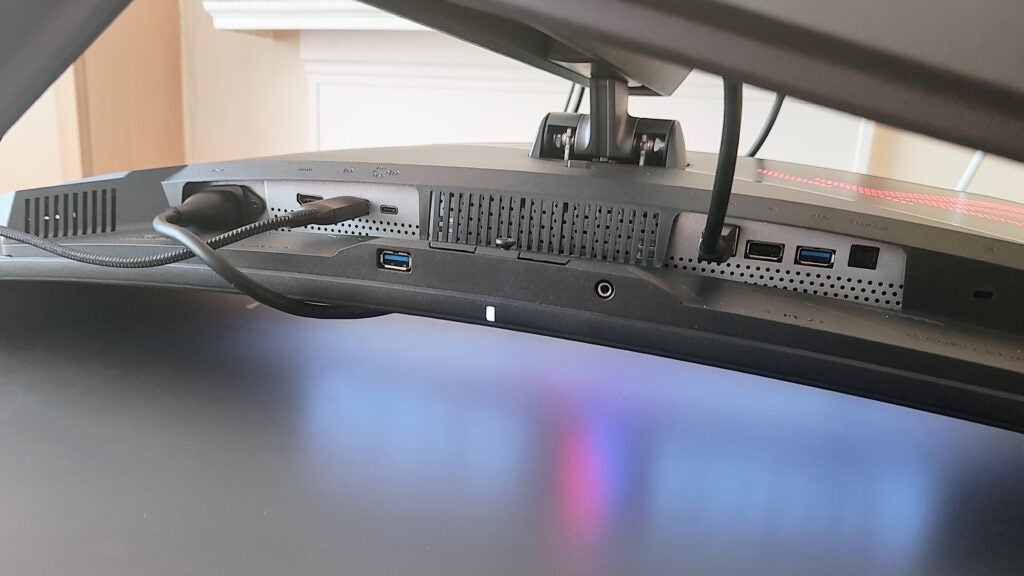
You’ll find single DisplayPort 1.4 DSC and HDMI 2.1 video inputs at the back of the cabinet and a 90W DP Alt Mode Type-C port. Next to them are three USB ports, a USB-B and two Type-A ports, one v2.0 and one v3.2 Gen 1, along with a SPDIF Optical Digital Audio Out socket.
There’s another USB-A 2.0 on the top of the cabinet and another USB-A 3.2 Gen 1 on the cabinet’s underside, along with a 3.5mm audio jack. Between those last two sits the OSD joystick, which is bracketed by menu close and power buttons.
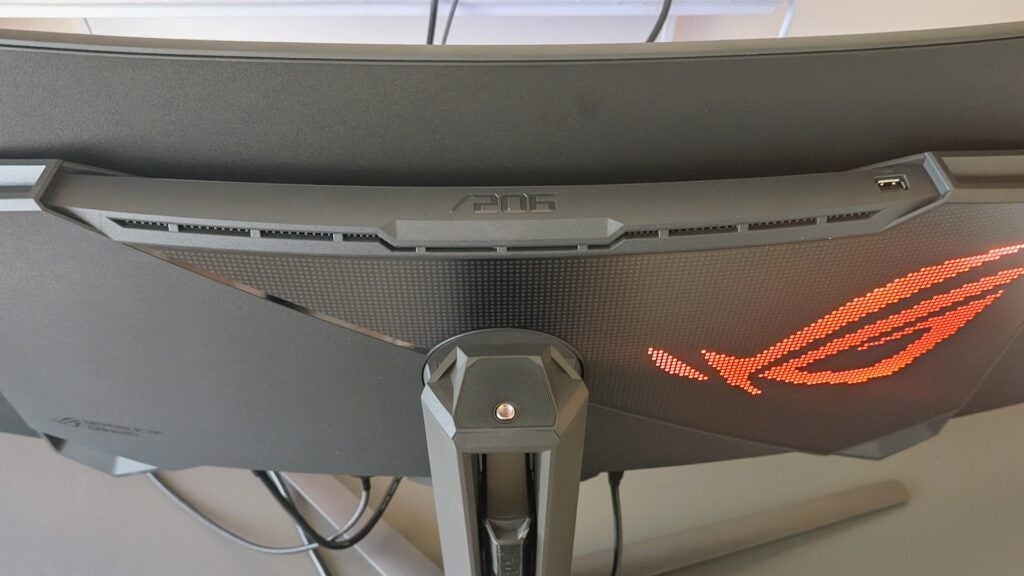
Asus makes no environmental claims on behalf of the PG49WCD, but the packaging is entirely cardboard and therefore easily recycled.
Image Quality
- Bright in SDR and HDR modes
- Motion handling is excellent
- Wide colour gamuts and accurate
Technically, the Asus ROG Swift OLED PG49WCD is very impressive. First, plenty of colour is available with gamut coverages of 99.9% sRGB, 98.5% DCI-P3 and 97.2% Adobe RGB. There’s an sRGB clamp, so you can lock the display to that profile and get a high level of colour accuracy, in this case, a very impressive Delta E figure of 0.93, though the maximum brightness is limited to 268nits in sRGB mode.
Switch the sRGB clamp off, and in SDR mode, peak brightness jumps to 413nits (in Cinema colour mode), which is high for an OLED display, while in HDR mode, it increases further to 468nits from a 10% screen area and 903nits from a <2% screen area, as near as makes no difference, and within measurement errors, to Asus claimed 1,000nits. Those high brightness levels mean there are no reflection issues with the high gloss finish of the panel.
It’s also worth noting that the Asus ROG Swift OLED PG49WCD is brighter than the Samsung G95SC even though the two use the same basic panel.
Due to the zero-level backlight levels inherent in OLED technology, the contrast ratio is infinite in both SDR and HDR modes. The PG49WCD has a VESA DisplayHDR400 TrueBlack certificate, the lowest TrueBlack rating. However, HDR performance is still excellent, especially in Gaming and Cinema modes, which reduces the clipping and brightness limitations that seem to be features of the Console and HDR400 HDR modes.
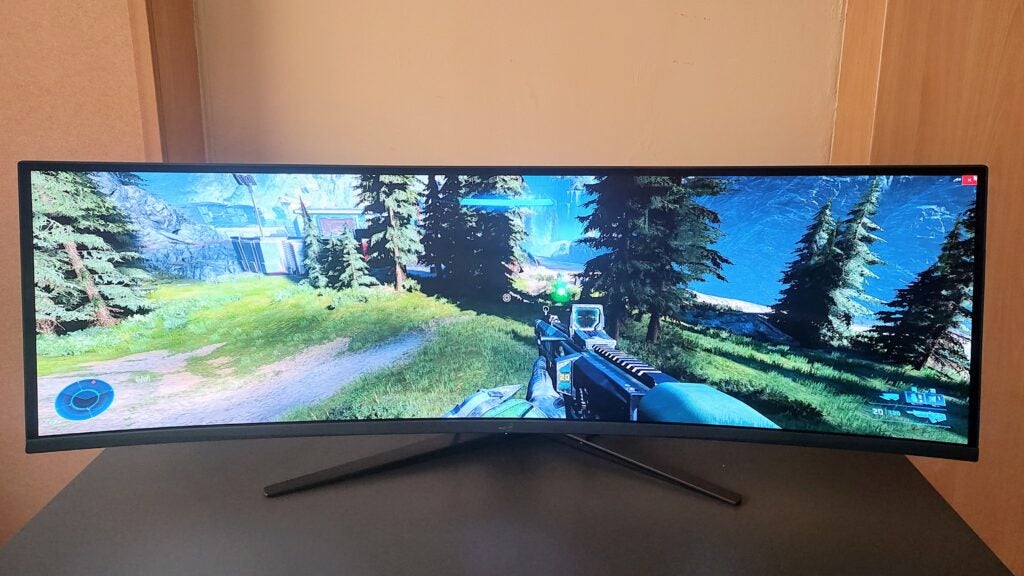
The screen demonstrated superb uniformity in brightness and ISO 14861 registration. The measurements were taken with the Display Uniformity function turned off, so the excellent results didn’t come at the expense of brightness, with each of the 25 test swatches exceeding 400nits. The gamma reading of 2.19 was close to ideal and I’ve no argument with the color temperature of 5917K.
Asus has limited the refresh rate on the Asus ROG Swift OLED PG49WCD to 144Hz, which is odd considering the direct competition from Samsung (the G95SC), Philips Evnia (the 49M2C8900) and MSI (Project 491C), which use the same Samsung-made panel, all refresh at 240Hz. That said, a 144Hz OLED panel with a low G2G response time (Asus quotes 0.03ms) is still capable of exceptional motion fidelity with smearing, blurring and ghosting all absent.
In the real world, I don’t think the 144hz refresh rate is a problem and here’s why: My RTX 4080 gaming PC can only hit around 150fps in the titles I use to test gaming monitors – Cyberpunk 2077, Halo Infinite and Metro: Exodus – when running at 5K with maximum detail levels and full ray tracing. The extra half-dozen frames-per-second that are being lost are meaningless, especially when all three titles look as good as they do on the PG49WCD; they are bright, saturated and visually wholly fluid. I’d argue that the case can be made for a higher refresh rate only when it comes to hardcore eSports.
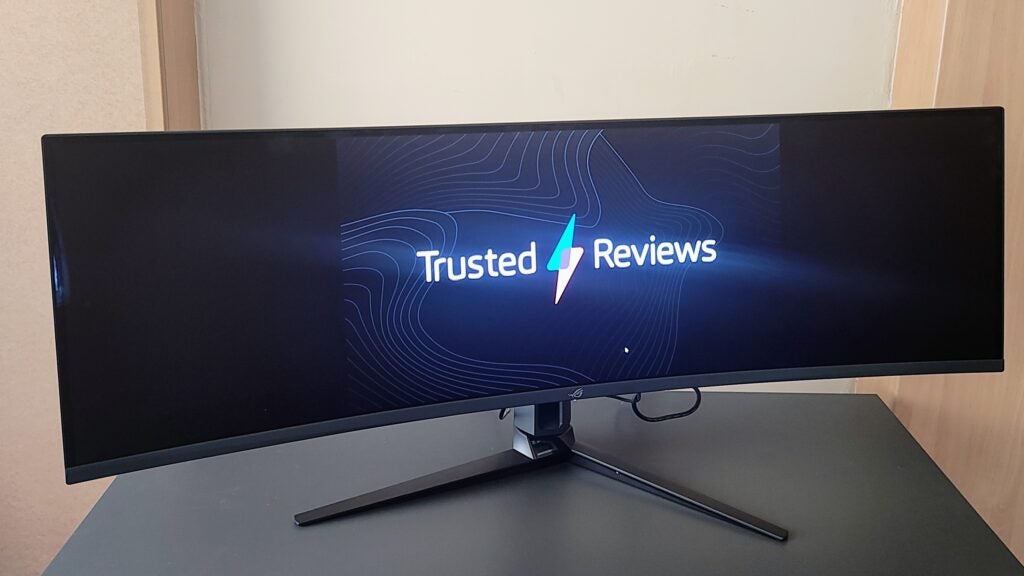
The Asus ROG Swift OLED PG49WCD is certified for both AMD FreeSync Premium Pro and VESA Adaptive Sync, and it works perfectly well with Nvidia’s G-Sync, even though it’s not officially G-Sync compatible. Either way, you will experience no issues with screen tearing whether you are hooked up to a console, an AMD GPU or an Nvidia GPU.
Turning for a moment to non-gaming performance, it’s worth mentioning that the panel in the Asus is a second-generation QD-OLED type with an improved subpixel structure. We are still talking about a triangular RGB layout, but the sizing of the subpixels has been adjusted to improve text clarity over the first-generation panels.
There is still a tiny amount of pink/green fringing around text, but it’s far less noticeable than it used to be, and once you increase the Windows scale, it effectively disappears. Text will be sharper on a good quality 5K LCD panel, but the difference can no longer be noticed with the unaided eye in general use.
Software and Features
- Proper KVM implementation
- Simply OSD menu
- OLED prevention features baked in
The wide selection of I/O ports allows for a proper KVM implementation, so swapping between sources using the same peripherals is very straightforward. Install Asus’ Smart KVM app, and you don’t need to manually select which source you want to work with; just move your cursor from one screen to the next. You can even drag content between the two screens.
The OSD menu system is a model of logic and simplicity with all the settings grouped as any sane person would expect. Still, if you prefer an on-screen solution, the ASUS DisplayWidget Center is supported, which, once downloaded and installed, lets you manage the monitor settings from the Windows desktop. In the menus, you’ll find a handy selection of gaming features under the GamePlus banner, including a stopwatch, crosshair, timer, frame rate counter, sniper mode and a screen alignment scheme to help you line up two monitors.
There are also a raft of features to prevent burn-in, the long-standing worry of OLED display owners, though frankly, not one to dwell on if you plan on using your monitor primarily for gaming because static images tend to be the problem.
To combat this, Asus has installed several features, including screen movement (which shifts the entire display image a few pixels to the left/right or up/down), pixel refresh, automatic logo brightness reduction and a dimming screen saver. All these features work in the background and should ensure that image burn isn’t anything you’ll experience.
Latest deals
Should you buy it?
If you want sumptuous, immersive, fluid SDR and HDR performance
The wide colour gamuts and impressive brightness in both SDR and HDR modes mean that AAA games look glorious.
If you want the highest possible refresh rates
144Hz isn’t bad for a gaming monitor, but if you play eSports, you probably need at least 240Hz and arguably 360Hz or more.
Final Thoughts
The refresh rate is the only stick you can poke the Asus ROG Swift OLED PG49WCD with. 144Hz is not per se bad, but there are three other monitors on the market that use the same basic Samsung panel but are clocked to 240Hz. Should you care? I’d argue only if you want a panel for competitive eSports where every last hertz counts, but if that’s the case, I’d suggest looking for a 360Hz or higher display.
Assuming that you want a sumptuous 5K OLED display to take full advantage of how good many AAA games look in HDR at the highest detail levels and with ray-traced lighting, then you’ll need one heck of a PC to get frame rates much beyond 144hz. The vast majority of gamers will be content with 144Hz, I know I am.
Every other feature of the Asus ROG Swift OLED PG49WCD is impressive, not least the levels of brightness and uniformity, which are class-leading for a big OLED display. The PG49WCD is roughly the same price as the Samsung G95SC, though the G85SC model, which is the same but lacks the (arguably pointless) Tizen smart-TV features, should be cheaper if it’s ever launched in the UK.
Given the cost of the obvious competition, and the inherent quality of the product, it’s hard not to see the ROG Swift OLED PG49WCD as solid value for money. Check out our Best Gaming Monitor guide for more options.
How we test
We use every monitor we test for at least a week. During that time, we’ll check it for ease of use and put it through its paces by using it for both everyday tasks and more specialist, colour-sensitive work.
With gaming monitors, we also put in some serious hours playing a selection of AAA titles. We also check its colours and image quality with a colourimeter to test its gamut coverage and the display’s technical quality.
We used a colorimeter to get benchmark results.
We use our own expert judgement for image quality
We used it as our main monitor for at least a week.
FAQs
With a high-quality 5K OLED panel and fast response time of 0.3ms, a 144Hz refresh rate and support for both AMD FreeSync Premium Pro and Nvidia G-Sync yes it is.
You need to spend some serious money to get a 49-inch ultra-wide OLED gaming monitor, and the £1399 asking price is average. Samsung’s competing G95 is similar, while the Evnia competition is slightly more expensive.




